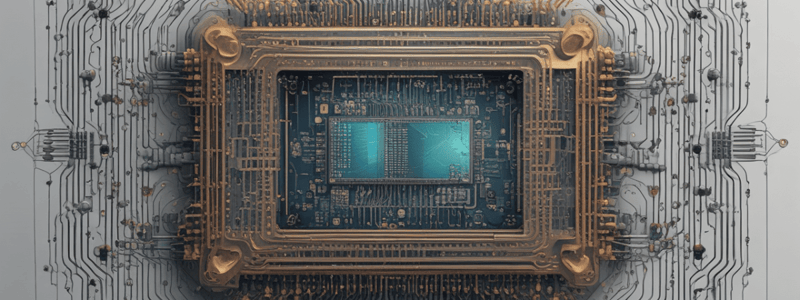Podcast
Questions and Answers
What is the term for the voltage at which the SCR enters the forward-conduction region?
What is the term for the voltage at which the SCR enters the forward-conduction region?
- Gate Trigger Voltage
- Forward Breakover Voltage (correct)
- Peak Reverse Voltage
- Holding Voltage
What is the minimum current required to switch the SCR from forward-blocking to forward-conducting region?
What is the minimum current required to switch the SCR from forward-blocking to forward-conducting region?
- Peak Reverse Current
- Holding Current
- Average Forward Current
- Gate Trigger Current (correct)
What is the maximum continuous anode current that an SCR can withstand?
What is the maximum continuous anode current that an SCR can withstand?
- Peak Reverse Voltage
- Gate Trigger Current
- Holding Current
- Average Forward Current (correct)
What is the product of the square of forward surge current and the time of duration of the surge?
What is the product of the square of forward surge current and the time of duration of the surge?
What is the typical value of gate current required to turn on an SCR?
What is the typical value of gate current required to turn on an SCR?
When an SCR is operated from an AC supply, what should be ensured?
When an SCR is operated from an AC supply, what should be ensured?
What is the advantage of using an SCR over a mechanical switch?
What is the advantage of using an SCR over a mechanical switch?
How is the SCR turned off from the ON state?
How is the SCR turned off from the ON state?
What is the purpose of forced commutation?
What is the purpose of forced commutation?
What is the typical current handling capacity of an SCR?
What is the typical current handling capacity of an SCR?
What is the effect of increasing the gate current above the required value?
What is the effect of increasing the gate current above the required value?
Flashcards are hidden until you start studying
Study Notes
SCR Basics
- SCR is a four-layer PNPN device with three terminals: anode, cathode, and gate.
- Similar to a four-layer diode, but with three terminals.
SCR Normal Operation
- Supply voltage is generally less than breakover voltage value at IG=0.
- SCR is turned on by passing an appropriate amount of gate current (a few mA).
- SCR must not exceed the reverse breakdown voltage when operated from an AC supply.
- To turn off an SCR, anode current should be reduced to holding current.
- Increasing gate current above the required value can cause the SCR to close at a much reduced supply voltage.
SCR as a Switch
- Advantages over mechanical or electromechanical switches:
- No moving parts, resulting in noiseless operation at high efficiency.
- High switching speed, up to 10^9 operations per second.
- Control over large current (30-100 A) in the load by means of a small gate current (a few mA).
- Small size and trouble-free service.
Turning off an SCR
- Anode current interruption: suppressing anode current from going through the anode to the cathode terminal.
- Methods: series switch and parallel switch.
- Forced commutation: momentarily forcing current through the SCR in the opposite direction to reduce net forward current below holding value.
SCR Characteristics and Ratings
- Forward Breakover Voltage (VBR(F)): voltage at which SCR enters forward-conduction region.
- Holding Current (IH): anode current value below which SCR switches from forward-conducting to forward-blocking region.
- Gate Trigger Current (IGT): gate current value necessary to switch SCR from forward-blocking to forward-conducting region.
- Gate Trigger Voltage (VGT): voltage across gate-cathode junction that turns SCR on.
- Average Forward Current (IF(AVG)): maximum continuous anode current SCR can withstand in forward-conducting region.
- Peak Reverse Voltage (PRV): maximum reverse voltage that can be applied to an SCR without conducting in a reverse direction.
- Circuit Fusing Rating: product of square of forward surge current and time of duration of the surge.
Studying That Suits You
Use AI to generate personalized quizzes and flashcards to suit your learning preferences.



